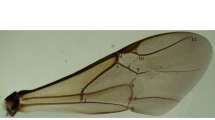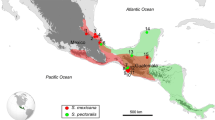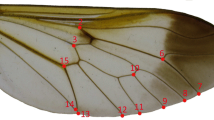Abstract
The stingless bee Melipona beecheii presents great variability and is considered a complex of species. In order to better understand this species complex, we need to evaluate its diversity and develop methods that allow geographic traceability of the populations. Here we present a fast, efficient, and inexpensive means to accomplish this using geometric morphometrics of wings. We collected samples from Mexico, Guatemala, El Salvador, Nicaragua, and Costa Rica and we were able to correctly assign 87.1% of the colonies to their sampling sites and 92.4% to their haplotype. We propose that geometric morphometrics of the wing could be used as a first step analysis leaving the more expensive molecular analysis only to doubtful cases.




Similar content being viewed by others
References
Aizen, M.A., Harder, L.D. (2009) The global stock of domesticated honey bees is growing slower than agricultural demand for pollination. Curr. Biol. 19, 915–918
Aizen, M.A., Garibaldi, L.A., Cunningham, S.A., Klein, A.M. (2009) How much does agriculture depend on pollinators? Lessons from long term trends in crop production. Ann. Bot. 103, 1579–1588
Biesmeijer, J.C., Roberts, S.P., Reemer, M., Ohlemueller, R., Edwards, M., Peeters, T., Schaffers, A., Potts, S.G., Kleukers, R., Thomas, C.D., Settele, J., Kunin, W.E. (2006) Parallel declines in pollinators and insect-pollinated plants in Britain and the Netherlands. Science 313, 351–354
Bischoff, I., Schroeder, S., Misof, B. (2009) Differentiation and range expansion of North American squash bees Peponapis pruinosa (Apidae: Apiformes) populations assessed by geometric wing morphometry. Ann. Entomol. Soc. Am. 102, 60–69
Bookstein, F.L. (1991) Morphometric tools for landmark data. Cambridge University Press, Cambridge
Brown, M.J.F., Paxton, R.J. (2009) The conservation of bees: a global perspective. Apidologie 40, 410–416
Byrne, A., Fitzpatrick, Ú. (2009) Bee conservation policy at the global, regional and national levels. Apidologie 40, 194–211
De la Rúa, P., de May-Itzá, W.J., Serrano, J., Quezada-Euán, J.J.G. (2007) Sequence and RFLP analysis of the ITS2 ribosomal DNA in two Neotropical social bees, Melipona beecheii and Melipona yucatanica (Apidae: Meliponini). Insect. Soc. 54, 418–423
Estoup, A., Garnery, L., Solignac, M., Cornuet, J.M. (1995) Microsatellite variation in honeybee (Apis mellifera L.) populations: hierarchical genetic structure and test of the infinite allele and stepwise mutation models. Genetics 140, 679–695
Franck, P., Garnery, L., Solignac, M., Cornuet, J.M. (2000) Molecular confirmation of a fourth lineage in honeybees from the Near East. Apidologie 31, 167–180
Francisco, F.O., Nunes-Silva, P., Francoy, T.M., Wittmann, D., Imperatriz-Fonseca, V.L., Arias, M.C., Morgan, E.D. (2008) Morphometrical, biochemical and molecular tools for assessing biodiversity. An example in Plebeia remota (Holmberg, 1903) (Apidae, Meliponini). Insect. Soc. 55, 231–237
Francoy, T.M., Wittmann, D., Drauschke, M., Müller, S., Steinhage, V., Bezerra-Laure, M.A.F., De Jong, D., Gonçalves, L.S. (2008) Identification of Africanized honey bees through wing morphometrics: two fast and efficient procedures. Apidologie 39, 488–494
Francoy, T.M., Silva, R.A.O., Nunes-Silva, P., Menezes, C., Imperatriz-Fonseca, V.L. (2009a) Gender identification of five genera of stingless bees (Apidae, Meliponini) based on wing morphology. Genet. Mol. Res. 8, 207–214
Francoy, T.M., Wittmann, D., Steinhage, V., Drauschke, M., Müller, S., Cunha, D.R., Nascimento, A.M., Figueiredo, V.L.C., Simões, Z.L.P., De Jong, D., Arias, M.C., Gonçalves, L.S. (2009b) Morphometric and genetic changes in a population of Apis mellifera after 34 years of Africanization. Genet. Mol. Res. 8, 709–717
Freitas, B.M., Imperatriz-Fonseca, V.L., Medina, L.M., Kleinert, A.M.P., Galetto, L., Nates-Parra, G., Quezada-Euán, J.J.G. (2009) Diversity, threats and conservation of native bees in the neotropics. Apidologie 40, 332–346
González-Acereto, J.A., Quezada-Euán, J.J.G., Medina-Medina, L.A. (2006) New perspectives for stingless beekeeping in the Yucatan: results of an integral program to rescue and promote the activity. J. Apic. Res. 45, 234–239
Kandemir, I., Moradi, M.G., Özden, B., Özkan, A. (2009) Wing geometry as a tool for studying the population structure of dwarf honey bees (Apis florea Fabricius 1876) in Iran. J. Apic. Res. 48, 238–246
Klein, A.M., Vaissière, B., Cane, J.H., Steffan-Dewenter, I., Cunningham, S.A., Kremer, C., Tscharntcke, T. (2007) Importance of pollinators in changing landscapes for world crops. Proc. R. Soc. Lond. B. 274, 303–313
Kremen, C., Ricketts, T. (2000) Global perspectives on pollination disruptions. Conserv. Biol. 14, 1226–1228
Kremen, C., Williams, N.M., Thorp, R.W. (2002) Crop pollination from native bees at risk from agricultural intensification. Proc. Natl. Acad. Sci. USA 99, 16812–16816
May-Itzá, W.J., Quezada-Euán, J.J.G., Enriquez, E., De la Rua, P. (2009) Intraspecific variation in the stingless bee Melipona beecheii assessed with PCR-RFLP of the ITS1 ribosomal DNA. Apidologie 40, 549–555
Mendes, M.F.M., Francoy, T.M., Nunes-Silva, P., Menezes, C., Imperatriz-Fonseca, V.L. (2007) Intra-populational variability of Nannotrigona testaceicornis Lepeletier 1836 (Hymenoptera, Meliponini) using relative warp analysis. Biosci. J. 23, 147–152
Monteiro, L.R., Reis, S.F. (1999) Princípios de Morfometria Geométrica, Holos Editora, Ribeirão Preto
Morrone, J.J. (2006) Biogeographic areas and transition zones of Latin America and the Caribbean Islands based on panbiogeographic and cladistic analyses of the entomofauna. Annu. Rev. Entomol. 51, 467–494
Nogueira-Neto, P. (1997) Vida e criação de abelhas indígenas sem ferrão, Nogueirapis, São Paulo
Potts, S.G., Biesmeijer, J.C., Kremen, C., Neumann, P., Schweiger, O., Kunin, W.E. (2010) Global pollinator declines: trends, impacts and drivers. Trends. Ecol. Evol. doi:10.1016/j.tree.2010.01.007
Quezada-Euán, J.J.G., Paxton, R.J., Palmer, K.A., de May-Itzá, W.J., Tay, W.T., Oldroyd, B.P. (2007) Morphological and molecular characters reveal differentiation in a Neotropical social bee, Melipona beecheii (Apidae: Meliponini). Apidologie 38, 247–258
Quezada-Euán, J.J.G., López-Velasco, A., Pérez-Balam, J., Moo-Valle, H., Velazquez-Madrazo, A., Paxton, R.J. (2011) Body size differs in workers produced across time and is associated with variation in the quantity and composition of larval food in Nannotrigona perilampoides (Hymenoptera, Meliponini). Insect. Soc. 58, 31–38
Rodrigues, F.M., Diniz-Filho, J.A.F. (1998) Hierarchical structure of genetic distances: effects of matrix size, spatial distribution and correlation structure among gene frequencies. Gen. Mol. Biol. 21, 233–240
Rohlf, F.J. (1989) NTSYS-PC: numerical taxonomy and multivariate analysis system. Exeter Publishing Co., New York
Rohlf, F.J. (2005) tpsDig2, version 2.04, Department of Ecology and Evolution, State University of New York, Stony Brook
Ruttner, F. (1988) Biogeography and taxonomy of honeybees. Springer, Berlin
StatSoft Inc (2001) STATISTICA (data analysis software system), version 6. www.statsoft.com
Tamura, K., Dudley, J., Nei, M., Kumar, S. (2007) MEGA4: Molecular Evolutionary Genetics Analysis (MEGA) software version 4.0. Mol. Biol. Evol. 24, 1596–1599
Tofilsky, A. (2008) Using geometric morphometrics and standard morphometry to discriminate three honey bee subspecies. Apidologie 39, 558–563
Whitfield, C.W., Behura, S.K., Berlocher, S.H., Clark, A.G., Johnston, J.S., Sheppard, W.S., Smith, D.R., Suarez, A.V., Weaver, D., Tsutsui, N.D. (2006) Thrice out of Africa: ancient and recent expansions of the honey bee, Apis mellifera. Science 314, 642–645
Winfree, R., Aguilar, R., Vásquez, D.P., LeBuhn, G., Aizen, M.A. (2009) A meta-analysis of bees’ responses to anthropogenic disturbances. Ecology 90, 2068–2076
Acknowledgments
We thank FAPESP (04/15801-0 to V.L.I.F.), CNPq (151947/2007-4 to T.M.F.) and Project 103341 Sep-Conacyt “Conservación de abejas sin aguijón de México” for providing scholarships and financial support. We also thank Dr. Marina Meixer and two anonymous reviewers for helpful comments and Dr. David De Jong for revising the manuscript.
Morphométrie géométrique de l’aile : un outil pour attribuer des lignées génétiques et une origine géographique à Melipona beecheii (Hymenoptera: Meliponini).
Morphométrie / aile / conservation / méthode d’identification / lignée génétique / population
Zusammenfassung – Geometrische Morphometrie des Flügels als Werkzeug für die Zuordnung zu genetischen Linien und geographischem Ursprung bei Melipona beecheii (Hymenoptera:Meliponini) Die stachellose Biene Melipona beecheii spielt in ökologischer, ökonomischer und historischer Hinsicht in ganz Mittelamerika eine bedeutsame Rolle. Die ausgedehnte geographische Verbreitung dieser Biene hat eine bemerkenswerte genetische Variabilität zur Folge, die mit molekularen Methoden gut untersucht werden kann. Heute wird davon ausgegangen, dass es sich bei M. beecheii in Wirklichkeit um einen Artenkomplex handelt, und es werden einige Anstrengungen unternommen, um diese bedrohte Gruppe zu erhalten. Zu diesem Zweck ist eine schnelle und preiswerte Methode zur Bestimmung von Proben aus verschiedenen Regionen des Verbreitungsgebiets wichtig. Wir stellen hier mit der geometrischen Morphometrie der Flügel eine effektive, schnelle und billige Alternative vor, mit der Völker von M. beecheii einer genetischen Linie zugeordnet werden können und darüber hinaus ihr geographischer Ursprungsort ermittelt werden kann. Wir haben dazu Proben im gesamten geographischen Verbreitungsgebiet der Art gesammelt und waren auf der Basis von Flügelmerkmalen in der Lage, 87.1% der Proben den Sammelorten sowie 92.4% dem korrekten genetischen Haplotyp zuzuordnen. Wir konnten auch bestätigen, dass ein Zusammenhang zwischen den morphologischen Distanzen der verschiedenen Gruppen und den geographischen Distanzen zwischen den Sammelorten besteht, was darauf hindeutet, dass zwischen den Populationen Isolation durch Distanz besteht. Auf der Grundlage dieser Ergebnisse schlagen wir vor, dass als ein erster Schritt in der Identifizierung unbekannter Proben die geometrische Morphometrie der Flügel durchgeführt werden sollte und damit wesentlich kostspieligeren molekularen Analysen auf zweifelhafte Fälle beschränkt bleiben können.
Melipona beecheii / geometrische Morphometrie/ Flügelmorphometrie / Erhaltung / genetische Linien
Author information
Authors and Affiliations
Corresponding author
Additional information
Manuscript editor: Marina Meixner
Electronic supplementary material
Below is the link to the electronic supplementary material.
ESM 1
(DOC 115 kb)
Rights and permissions
About this article
Cite this article
Francoy, T.M., Grassi, M.L., Imperatriz-Fonseca, V.L. et al. Geometric morphometrics of the wing as a tool for assigning genetic lineages and geographic origin to Melipona beecheii (Hymenoptera: Meliponini). Apidologie 42, 499–507 (2011). https://doi.org/10.1007/s13592-011-0013-0
Received:
Revised:
Accepted:
Published:
Issue Date:
DOI: https://doi.org/10.1007/s13592-011-0013-0




